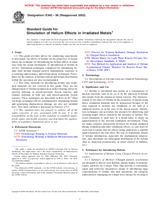Wir benötigen Ihre Einwilligung zur Verwendung der einzelnen Daten, damit Sie unter anderem Informationen zu Ihren Interessen einsehen können. Klicken Sie auf "OK", um Ihre Zustimmung zu erteilen.
ASTM E942-96(2003)
Standard Guide for Simulation of Helium Effects in Irradiated Metals
Automatische name übersetzung:
Standard-Leitfaden für die Simulation von Helium Effects in Bestrahlte Metals
NORM herausgegeben am 10.1.1996
Informationen über die Norm:
Bezeichnung normen: ASTM E942-96(2003)
Anmerkung: UNGÜLTIG
Ausgabedatum normen: 10.1.1996
SKU: NS-48543
Zahl der Seiten: 12
Gewicht ca.: 36 g (0.08 Pfund)
Land: Amerikanische technische Norm
Kategorie: Technische Normen ASTM
Die Annotation des Normtextes ASTM E942-96(2003) :
Keywords:
helium analysis, helium effects, ion irradiation, radiation damage, tritium trick
Ergänzende Informationen
| Significance and Use | ||||||||||
|
Helium is introduced into metals as a consequence of nuclear reactions, such as (n, α), or by the injection of helium into metals from the plasma in fusion reactors. The characterization of the effect of helium on the properties of metals using direct irradiation methods may be impractical because of the time required to perform the irradiation or the lack of a radiation facility, as in the case of the fusion reactor. Simulation techniques can accelerate the research by identifying and isolating major effects caused by the presence of helium. The word simulation is used here in a broad sense to imply an approximation of the relevant irradiation environment. There are many complex interactions between the helium produced during irradiation and other irradiation effects, so care must be exercised to ensure that the effects being studied are a suitable approximation of the real effect. By way of illustration, details of helium introduction, especially the implantation temperature, may determine the subsequent distribution of the helium (that is, dispersed atomistically, in small clusters in bubbles, etc.) |
||||||||||
| 1. Scope | ||||||||||
|
1.1 This guide provides advice for conducting experiments to investigate the effects of helium on the properties of metals where the technique for introducing the helium differs in some way from the actual mechanism of introduction of helium in service. Simulation techniques considered for introducing helium shall include charged particle implantation, exposure to -emitting radioisotopes, and tritium decay techniques. Procedures for the analysis of helium content and helium distribution within the specimen are also recommended. 1.2 Two other methods for introducing helium into irradiated materials are not covered in this guide. They are the enhancement of helium production in nickel-bearing alloys by spectral tailoring in mixed-spectrum fission reactors, and isotopic tailoring in both fast and mixed-spectrum fission reactors. These techniques are described in Refs (1-5). Dual ion beam techniques (6) for simultaneously implanting helium and generating displacement damage are also not included here. This latter method is discussed in Practice E 521. 1.3 This standard does not purport to address all of the safety concerns, if any, associated with its use. It is the responsibility of the user of this standard to establish appropriate safety and health practices and determine the applicability of regulatory limitations prior to use. |
||||||||||
| 2. Referenced Documents | ||||||||||
|
Empfehlungen:
Aktualisierung der technischen Normen
Wollen Sie sich sicher sein, dass Sie nur die gültigen technischen Normen verwenden?
Wir bieten Ihnen eine Lösung, die Ihnen eine Monatsübersicht über die Aktualität der von Ihnen angewandten Normen sicher stellt.
Brauchen Sie mehr Informationen? Sehen Sie sich diese Seite an.




 Cookies
Cookies
